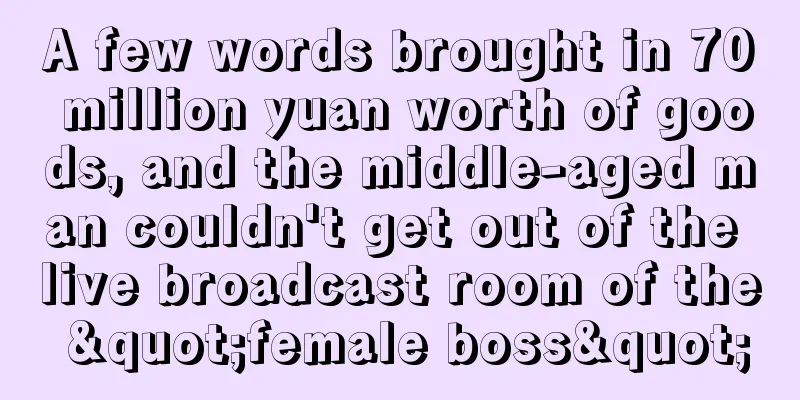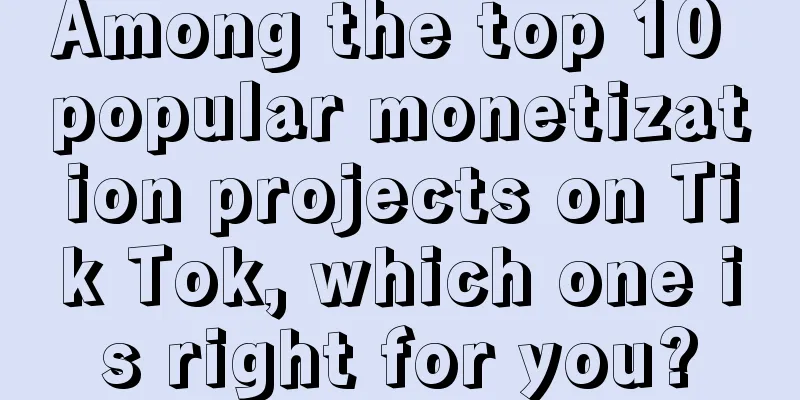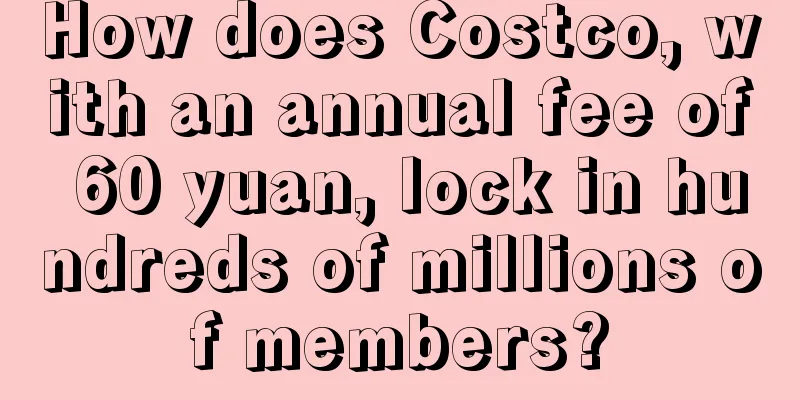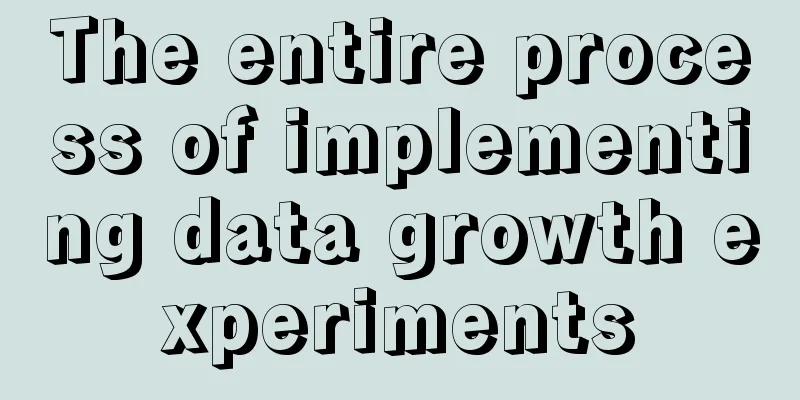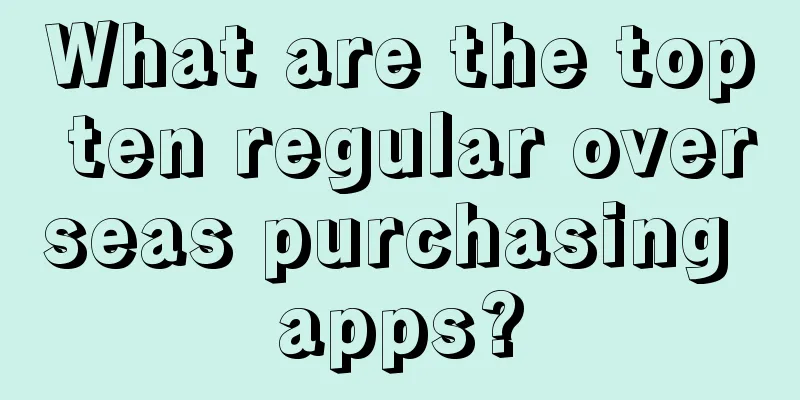Brand No. 1: Why do your products always have problems? Here are six steps to help you solve them

What is the product, what should the product be, what will the product be? For enterprises and organizations, no matter how many businesses you have, they should essentially revolve around one thing. From the perspective of the organization, it is called a business, and from the market perspective, each business should be part of the market value and customer value. For this reason, we say: the essence of a thing is to define the value of the company's internal business from the market perspective, which is why the so-called number one or number two principle exists. The resources of an enterprise are always relatively limited. No enterprise has so many resources that they don't need to be focused. Focusing on one thing is to focus the resources of the enterprise - to concentrate on doing big things. So what is the so-called one thing? To answer this question, we must return to basic questions and basic concepts. Sometimes we don’t think enough about basic issues, and often just pass them by or even without thinking. In order to avoid real thinking, people often choose not to think about what problems we want to solve and what value we can bring, rather than simply doing addition and subtraction - adding business segments when things are good and subtracting business segments when things are bad. As your experience increases, you will find that the shorter the time dimension, the harder it is to do it right, and the longer the time dimension, the easier it is to avoid making mistakes - people tend to over-exaggerate what they can accomplish in a year, and are overly pessimistic about what they can achieve in ten years . What problem do we want to solve? In fact, it is the ultimate question about the meaning of the existence of enterprises. For Jack Ma, it is: to make it easy to do business in the world; Musk said that he wants to liberate all mankind. To make it easier to do business in the world, this is Jack Ma’s ultimate question for what problems companies need to solve: What problems we want to solve is a choice made based on the company’s current capabilities, resources, and endowments. What problems can be solved is based on what problems we want to solve. What is the product, what should the product be, what will the product be, and on this basis, whether the business can be reorganized and how the business should be presented. In the final analysis, once the product issues are clear, the business can start thinking. Enterprise business is complicated and each department has its own interests. Whether it can be merged into one line is not only a business-level thinking, but also an iteration of cognition. As a business owner, you should pay special attention to the key few decisions in your business decisions. Only when you think deeply enough about the key few decisions, other decisions will be easy to make - or even self-defeating. On the contrary, if we do not think deeply about the key few decisions, then we will always be solving problems instead of solving them - what problems do we want to solve? What problems can we solve? How should our business be combined? How should our products be presented? 01Start with the category and find the big picture of the businessFirst, start with the category and find the big picture of the business: the category problem is not just a product problem, but also a market problem, a business "situation" problem. The starting point of a business should be a big market, and a big market can lead to big business - a big market is the foundation and premise of big business. Without this premise and foundation, you will find it more and more difficult to make ends meet. When you are in a tight spot, you will find that you made a mistake from the beginning - it is easy to make a big splash when you are right, but it is quiet when you are wrong. The same product will have different market territories if you have different ideas about its category concept. Sometimes this difference is not the difference between 1 and 10, but a tragedy of one heaven and one hell. For this reason, when people ask me how to make products, I usually ask what your category is and what you think your category should be. Many times, our thinking about products and categories is not enough, far from enough, or even wrong. Create a category or occupy a characteristic. Have you created a category or occupied a characteristic in a category? There are two types of businessmen in this world. One type understands business and does business. They believe in rules and know that business only has present tense, not past tense, and even less perfect tense. What kind of cognition leads to what kind of behavior, so they know what happened in the past means. There is also a kind of people who do business for the sake of business, but actually do not understand what business is. They simply treat buying and selling as business and turn it into business. Business is not just buying and selling. The biggest difference between a trader and a businessman lies in the dimension of thinking. What is business? Have you created a category or occupied a characteristic in a category? If you still don’t understand what a category is and what a characteristic is, I suggest you stop and think about it. Don’t rush into business but slowly discover the beauty of business. For example: if there is already a leading brand in this category, can you occupy different characteristics? 02 Start with the concept and find the basis of audience cognitionSecondly, start with the concept and find the basis of audience cognition: After the relationship between products and categories is straightened out, the next step is to start with the concept, with the goal of finding the basis of audience cognition. The concept here must not be a concept that you plan, invent, and innovate behind closed doors: the concept of eating by chewing or holding in the mouth is essentially a fantasy of consumers and audience cognition. Starting from the concept means starting from the cognition that customers already know and finding the concept that the audience cognizes. That is the source of power. Only when this source of power is found can the concept and cognition be equated. Otherwise, it is a concept imposed by the enterprise or even a fabricated concept. Did Jinmailang create the word "cooked water"? No, the word "cooked water" already existed. Jinmailang just used this mental resource to name its product category and called it "liangbaikai". 03Start with pricing and find reasons to support itThird, start with pricing and find supporting reasons: Pricing is not a simple number. Pricing is first of all positioning. Only with positioning can there be a support point for price. Who are you serving, showing to, and selling to? As a consumer, you have a budget in mind before buying. And this budget is your lock on the market and customers. First-rate entrepreneurs know how to set prices. Pricing is a thorough expression of an entrepreneur's commercial penetration and a judgment of market trends. 19.8 or 39 is ultimately a reason for purchase, and this reason for purchase comes from the understanding of positioning from beginning to end. Third-rate companies are engaged in price wars. Let’s look at a math problem first: What does it mean for a company if it can increase its product prices by an average of 2%, keeping sales volume and costs unchanged?
In the 4Ps of marketing, products can be discussed in terms of packaging and visual effects; channels can be discussed in terms of bonuses and mass penetration; promotion can be discussed in terms of content and KOLs. However, when it comes to price, there seems to be nothing to talk about. Often, the more obvious something is, the less likely it is to be discovered. Genuine goods, good quality and low price, good products are not cheap, cost-effectiveness, behind these familiar words are all talking about prices. The top ability of an entrepreneur is the sense of pricing. First-class companies can set prices, second-class companies do promotions, and third-class companies are Pinduoduo. 04Sound , text, music, four elementsGuo Degang said: In the crosstalk business, there is no one who is better than anyone else, there are only those who can and those who can’t, and the same is true in the marketing business. Marketing slogans must first be correct, secondly they must be shouted loudly, and also they must be shouted for a long time. Whether it is right, loud, or long, if it is right, loud, and long, it will naturally turn from virtual to real. If there is a universal truth in advertising, it is repetition, repetition, and repetition again. Only by repeating it tirelessly can it become familiar to the audience. In addition to slogans (text, sound), there must also be visuals. Whether it is a poster, a doorhead, or a media advertisement, only text and sound are not enough, and visual enhancement is essential - a gentleman will do everything he can to achieve the highest good and beauty. That is: the presentation of text, the expression of sound, and the enhancement of vision are all indispensable. Here we need to talk about the four dimensions of advertising slogans: text, sound, music, and music . In ancient times, music was used to make rituals: rituals without music were not rituals, and music without rituals was not music. Confucianism pays particular attention to the influence of music on people's hearts, and advocates that music should be beneficial to people's education rather than to stimulate the senses. Music dominated by the way of the gentleman is beneficial to human progress; music dominated by satisfying sensory stimulation will lead society to chaos. That's why there is the story of the red sun rising in the east... That's why there is the story of spring... People are governed by music, and rituals are established by music. Sound, tone and music are three different concepts. The difference between sound and tone is that tone has rhythm and pitch, but sound does not. The Book of Music says: "All sounds are born from the human heart. Emotions move in the heart, so they are expressed in sound. When sounds are expressed in words, they are called music." This means that only sounds that come from the heart and are expressed in words (with rhythm) can be called "sounds". Therefore, when we make advertisements, we should not only think about the advertisement text and slogan. We should have text, sound, and music, and most importantly, music. We should think about text and words, as well as sound, and plan the sound (emotions move in the heart, so they are expressed in sound; sound becomes text, which is called music) - sound can touch the heart and can cure diseases. Words are dead, like a tiger with wings, which moves like a tiger, very fierce and durable . If you want words to have legs (from a tiger to a tiger), and to move on their own, you need to give them (words, characters) legs of sound and voice, so that the words will be familiar and spread quickly. Voice is a rhythmic sound, and a word that cannot be pronounced is a "dead" sound, without any sound. Repeating words is boring, but with music, it can be repeated 100 times without being boring. You are the most beautiful star in the night sky, lighting my way forward. You are the most beautiful encounter in my life. If you are well, it will be a sunny day - Good morning China; Hello 2023. 05 Reach StrategyFrom brand users, to competitor users, to category users, to cross-category users, and finally to scenario users. Only by constantly breaking through the circle can we maintain growth, especially in the stage of crossing the chasm; this is even more true for achieving exponential growth - traffic, breaking the circle, conversion, operation, and sedimentation of mind. Based on consumer portrait labels and sales base data: define the brand's core portrait labels and lock in the A4-A5 core strategic groups: emerging white-collar workers, senior middle-class, sophisticated mothers, small town youth, Gen Z (Generation Z), urban silver-haired people, small town middle-aged and elderly people, and urban blue-collar workers. Based on the A4-A5 portraits, attract new user circles to increase traffic. That is: the right people (user portraits), multiple levels (5A stratification), and multi-dimensional reach (off-site, on-site). Through the analysis of the 5A of the crowd and brand users, we can clearly correspond the strategy to the crowds in different circles. The core of breaking the circle is to attract users other than A4-A5 types, and guide users to gradually settle into A2-A3 users through content, so as to prepare for traffic accumulation for sales conversion. According to the 5A population level, a reach combination of "brand advertising + content seeding + paid traffic" is formulated to achieve content reach across touchpoints/frequencies. Off-site: Based on data portraits, select brand advertising to reach the O-A1 population, stimulate conversion of the A1-3 population through short video influencers, and then cooperate with bidding advertising to convert them into the A4 population. On the site: Super Interactive City and Brand Special Show expose the "O-A1 group" (targeting the opportunity group) and reach new users. Use the through train to reach the "A2-3 group" with shopping intentions, stimulate users and deepen their behavior, use Diamond Exhibition to reach the "A3-A4 group" (interest group, purchase group), and use Product Sales to reach the "A4-A5 group" (purchase group, loyal group). 06 Coverage PossibilityPossibility of coverage: through what channels, media, advertising, and public relations can potential customers be covered . This is a question of the communication scope after the consumer's self-portrait. When talking about precise coverage, it is also precision under the premise of quantity. Without quantity, there is no quality. To achieve quality, you must first ensure quantity. This sentence is the same for coverage. For example, Xiaoxiandun focused on weight loss and skin care in 2018; in 2019, it enhanced the concept of pregnancy care and anti-aging, and increased the percentage of skin care products from 28% to 45%. This means that the combination of skin care and function is effective. After April 2019, the scenarios for Xiaoxiandun's advertising began to change. The proportion of "weight loss" scenarios decreased to 11%, and the proportion of "skin care" scenarios was the highest, accounting for more than 45% of the total. The proportion of "pregnancy care" and "freezing age" scenarios increased significantly, and the proportion of "health preservation" scenarios was still at the bottom. After 2020, we will increase awareness through super head + KOL placement. Select Zhang Yuqi, Zhang Ziyi, Jing Tian and other celebrities with the labels of "noble lady" and "exquisite" to promote Xiaoxiandun, which not only brings high exposure to the brand, but also subtly establishes the credibility of potential consumers for Xiaoxiandun. We used "weight loss", "skin care", "anti-aging", "health care", and "pregnancy care" as keywords for penetration, and gradually came up with core keywords: skin care as the main focus, health care as the foundation, pregnancy care, and anti-aging as the grass-planting strategy for penetration of the population. We did this through cross-border marketing, brand co-branding, seizing new dividends of stage traffic, creating momentum, public relations, and advertising. We achieved multi-dimensional and multi-scenario reach and coverage of the population and the general population.
Author: Houshan Keju, Source: WeChat public account “Lao Gao Business and Brand”. |
<<: With e-commerce blocked, TikTok turns to iQiyi, Youku and Tencent Video
>>: Understanding Xiaohongshu's Commercial Traffic in One Article
Recommend
Top 10 Marketing Keywords in the First Half of 2023
The first half of 2023 has passed, and many market...
ACG exhibition restarts with enthusiasm, and the bonus of ACG marketing is waiting to be tapped
This article focuses on the popularity of offline ...
Taylor Swift speaks Chinese, will this lead to a major change in marketing?
This article starts with the recently popular &quo...
“Bad” Marketing——Traffic Code for Brand Rejuvenation
Nowadays, more and more young people like to go ag...
What are the requirements for shopeeSpayLater? How to activate it?
Users who frequently shop on the Shopee platform m...
Copy homework! Teach you how to build an operations analysis system step by step
The analysis of a single operational action is cer...
Domestic brand building has taken a detour
Recently, Li Jiaqi's speech during the live br...
Douyin, Kuaishou and Weibo are full, iQiyi, Youku, Tencent and Mango TV are chasing them. Who will run wild in the short drama industry in 2023?
Today, short dramas are popular. Not only are WeCh...
After Taobao free orders, netizens catch up on cultural studies
This article uses the interesting case of Taobao&#...
Video accounts enter local life again
In the field of local life, the video account is a...
These 3 brands spent over a million on Xiaohongshu! Why did they disappear again?
Why did the brands that were popular on Xiaohongsh...
How to participate in Amazon's Transparency Program? How to apply for the Transparency Program?
Amazon's transparency program is designed to p...
What is the normal conversion rate of Amazon products? How to improve the conversion rate of Amazon products?
For every merchant, what they want to see most is ...
Why are people less and less interested in scanning codes?
Starting from the current situation that "peo...
If brands want to do well on Xiaohongshu, they must understand these logics!
This article will explain how to effectively promo...
